Part 1: The wildlife bits…
I am regularly on the lookout for activities and destinations that I might be able to “sell” to Nikki and the girls as a family holiday, with the (not-so) secret agenda of indulging some guilt-free birding for myself. Sadly I have been almost entirely unsuccessful with this plan, with the sole exception of a fantastic trip to New Caledonia in 2017 (see blog here). Could Borneo be a place that would excite the family for a holiday? In 2014 I had visited there for the first time, spending a few post-conference days on the Kinabatang River, “Borneo’s Amazon”. It was a brilliant experience and the birding was fabulous. And instead of trudging along leech-infested muddy rainforest trails, here you go birding and wildlife watching on the river, zooming up and down in tinnies, looking for a range of fantastic birds as well as primates, elephants and crocodiles. Despite these obvious attractions, I was unable to convince Nikki and Louisa, but gradually over the intervening years it became apparent that I had sown a seed with Erica, and at the end of her schooling she saw an opportunity to exploit her Dad’s hobby and good nature. During one stint of gap-year travel, she was already planning the next: would I take her to Borneo to look Orangutans? Why there? Why them? Perhaps, as a ginger herself, she feels a particular affinity! 🙂
Originally we planned just a couple of days at Sepilok and few days on the river, replicating my 2014 trip. But almost last-minute we added a couple of days near Kota Kinabalu, a non-birding extension to do the two-day hike up to the Mount Kinabalu summit.
The most economic flights we could find (and at the time the only ones with availability because we booked late) were with Qantas, Adelaide to Melbourne, Singapore then Kuala Lumpur, followed by Air Asia for the Malaysian domestic flights. What a faff! Then, as we travelled in a taxi to Adelaide airport Erica got a text from Qantas that the Melbourne-Singapore flight had been delayed and I worked out we would miss the connection in Singapore to KL. The faff was immediately upgraded to potential disaster; our next morning Air Asia flight from KL to Sandakan was now in jeopardy, possibly ruining the whole trip. Fortunately, as a Platinum Frequent Flyer, I get well-looked-after by Qantas, and at the desk they made a few calls and fiddled with computer a bit, managing to get us on the Malaysian Airlines flight that goes direct to KL from Adelaide, leaving in 2 hours. We could relax in the lounge in the knowledge that we’d arrive in KL still at least 3 hours ahead of schedule. Oh, and they put us in Premium Economy. That’s what I call a result!
As part of the experience (and to save money), we had decided to stay in a “capsule hotel” close to the airport. One for the list of life experiences, but the less said about that, the better: it’s not something either of us will be a rush to repeat!
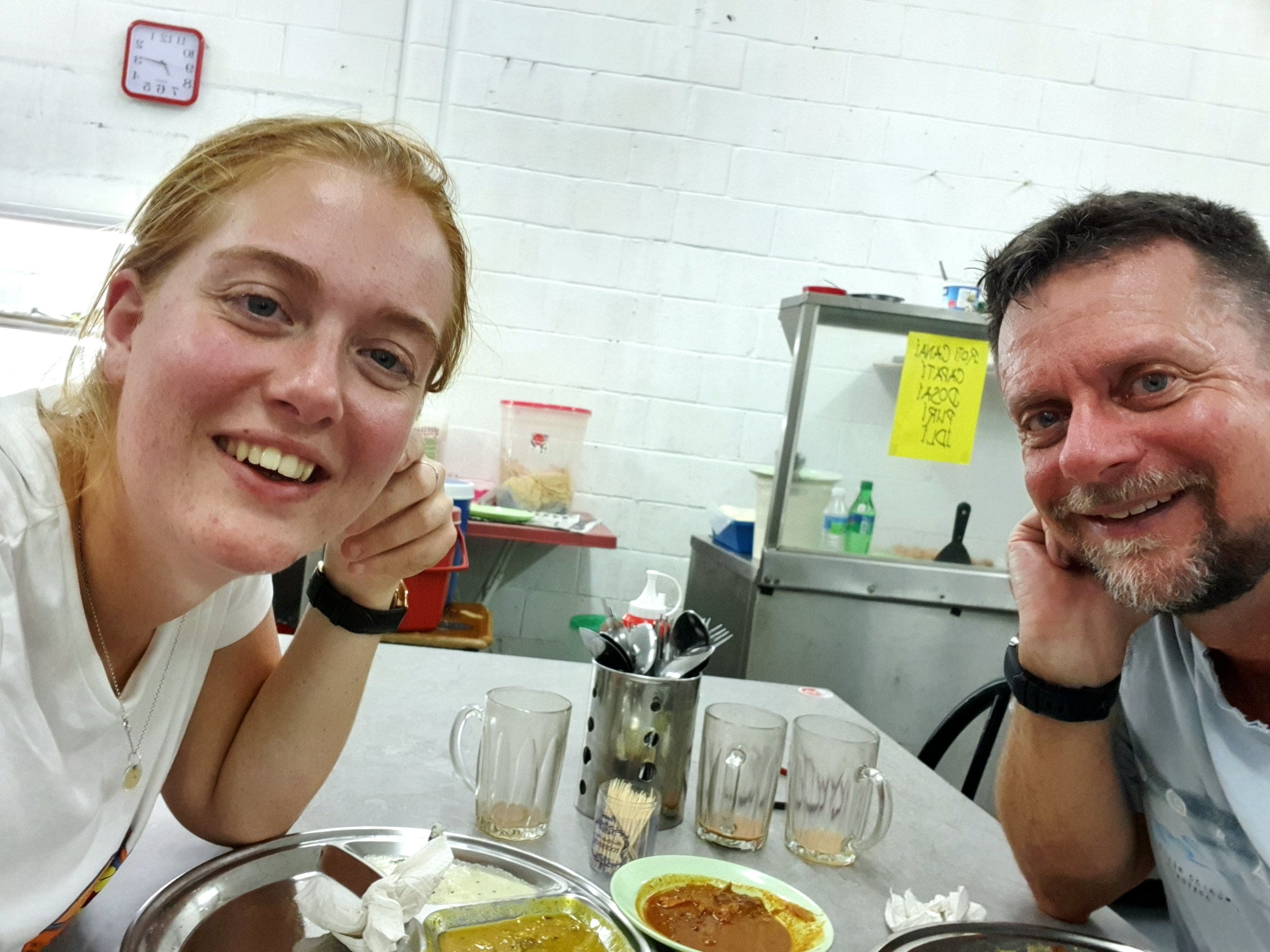
13 November
The next morning we were on our way on a very early morning flight to Sandakan and easily found a taxi to take us to Sepilok B&B where I had booked us for two nights. It was mid-morning by the time we’d arrived and settled into our spartan but comfortable room. There seemed to be very few – if any – other guests!
Our main objective once at the Kinabatang River was to find wild Orangutans. But we had come to Sepilok because here there is a rehab centre at the edge of a decent sized reserve of lowland rainforest. Orphaned orangs are brought up and gradually re-introduced to the wild here, and sightings of these rehab animals are almost guaranteed because of a feeding station with regular times. It’s not a zoo, so it is possible to miss them. But equally it is possible to see wild Orangutans here also, because the animals are free to come and go.
It took about 30 minutes to walk to the Sepilok Orangutan Rehabilitation Centre late morning. It was hot and sweaty work and because it took us longer than we’d thought we arrived only at the end of the designated feeding time. Luckily a single teenage female was still by the feeding station, and we and some stragglers from morning tour groups enjoyed a relaxed encounter with this beautiful, gentle beast. Further along the boardwalk a troop of Long-tailed Macaques were scavenging the leftovers from the rehab exercise area and we spied 5 more young rehab Orangutans walking from their “rooms” across the grass to disappear into the forest.


After lunch in a nearby restaurant and a quick snooze we headed back to the Rehab Centre to try to catch the afternoon feeding. We had nice encounters with a Grey-tailed Lace Snake and a pair of Giant Squirrell before making our way along the boardwalk to the feeding station.


This time we were there plenty early and the platform was visited by 6 Orangutans, including two babies. One of rangers noted that one of the younger “teenage” Orangutans, and one the babies are wild-born, so we had already seen proper wild animals, even if in a slightly artificial environment.










We took an evening stroll around the Rainforest Discovery Centre, not far from our B&B, along the canopy walkway and some of the ground-level trails. It was all rather quiet, but I did find lifer Black-winged Flycatchers, and a flock of Bushy-crested Hornbills and another snake – this one unidentified but spied by Eri on the path. We gave it a wide berth!
14 November
I rose early and left Erica to sleep in while I returned to RDC. I walked straight to an area where 5 years previous I’d had a brief but ultimately very satisfying encounter with a Black-crowned Pitta and proceeded to have an extended standoff with the same species – maybe even the same bird – that simply would not show itself. A gorgeous Rufous-backed Kingfisher put in an appearance while I waited for the pitta.
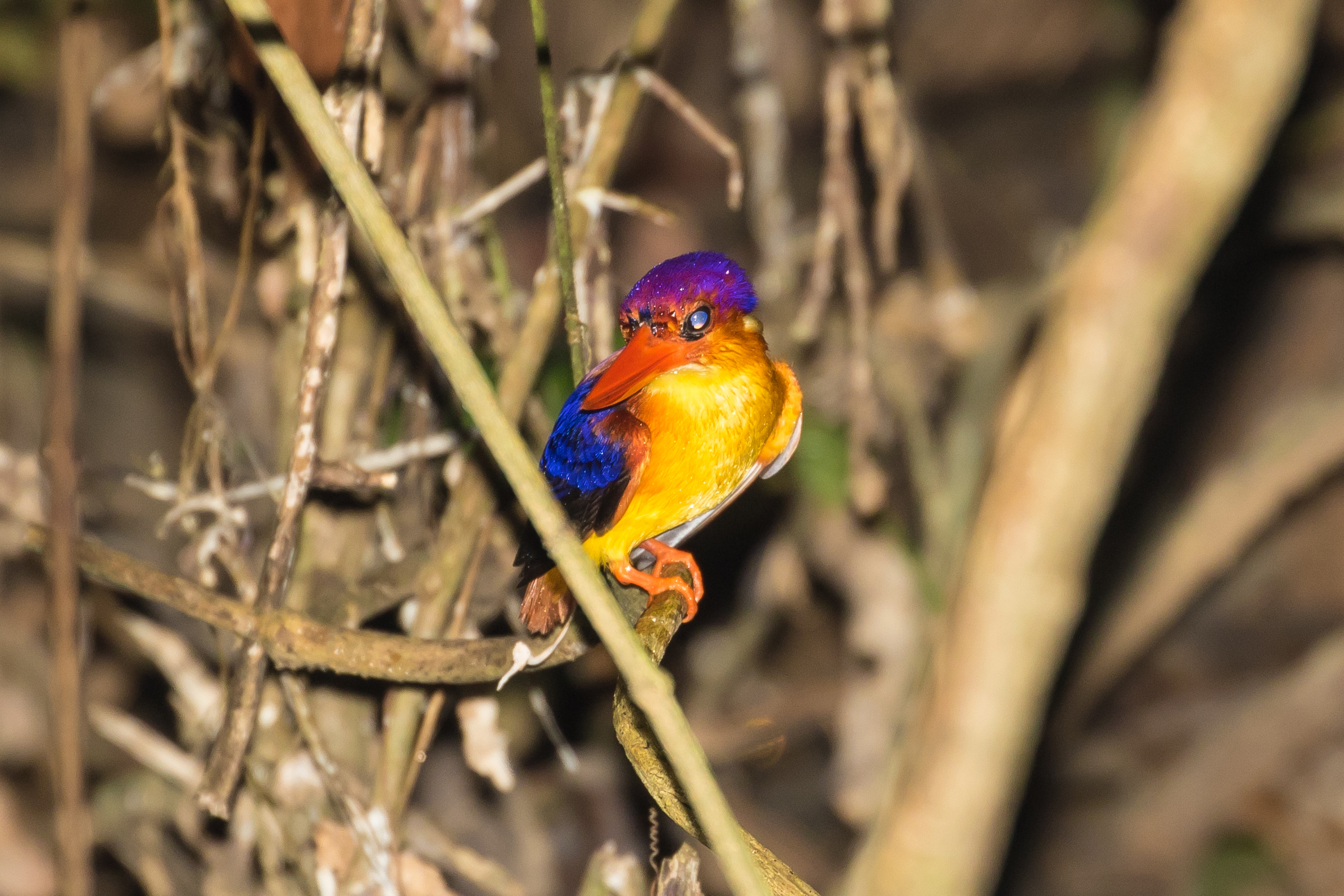
And loud grunting heralded the presence of a couple of Rhinocerous Hornbill which I noted briefly in flight. Eventually I gave up and left without even a sighting of the pitta, let alone the image I craved. Diard’s Trogon was a potential lifer target. I heard a trogon, and played Diard’s; it responded instantly to my playback by flying over the trail and landing invisibly and I failed to relocate it. I marked down BVD (“Better views desired”) in my notebook! Other birds noted this morning included Oriental Magpie Robin, Bornean Black Magpie and Maroon Woodpecker, as well as trash like Tree Sparrow, Yellow-vented Bulbul, and Zebra Dove. And a heard-only Scarlet-naped Trogon and Black-and-Yellow Broadbill.
On the way out something caught my eye distantly across a steep valley and I was excited to see a roosting Barred Eagle-Owl in my bins. It was very dark in the forest still, and the valley was too steep and muddy for me to attempt to get any closer, so these record shots are all I managed (when I typed that sentence initially I hit the “i”, next to the “o” for a more apt description, “record shits”). Not a lifer (see blog here) but what a cracking bird to see, and this one I found by myself rather than twitching in a golf resort!
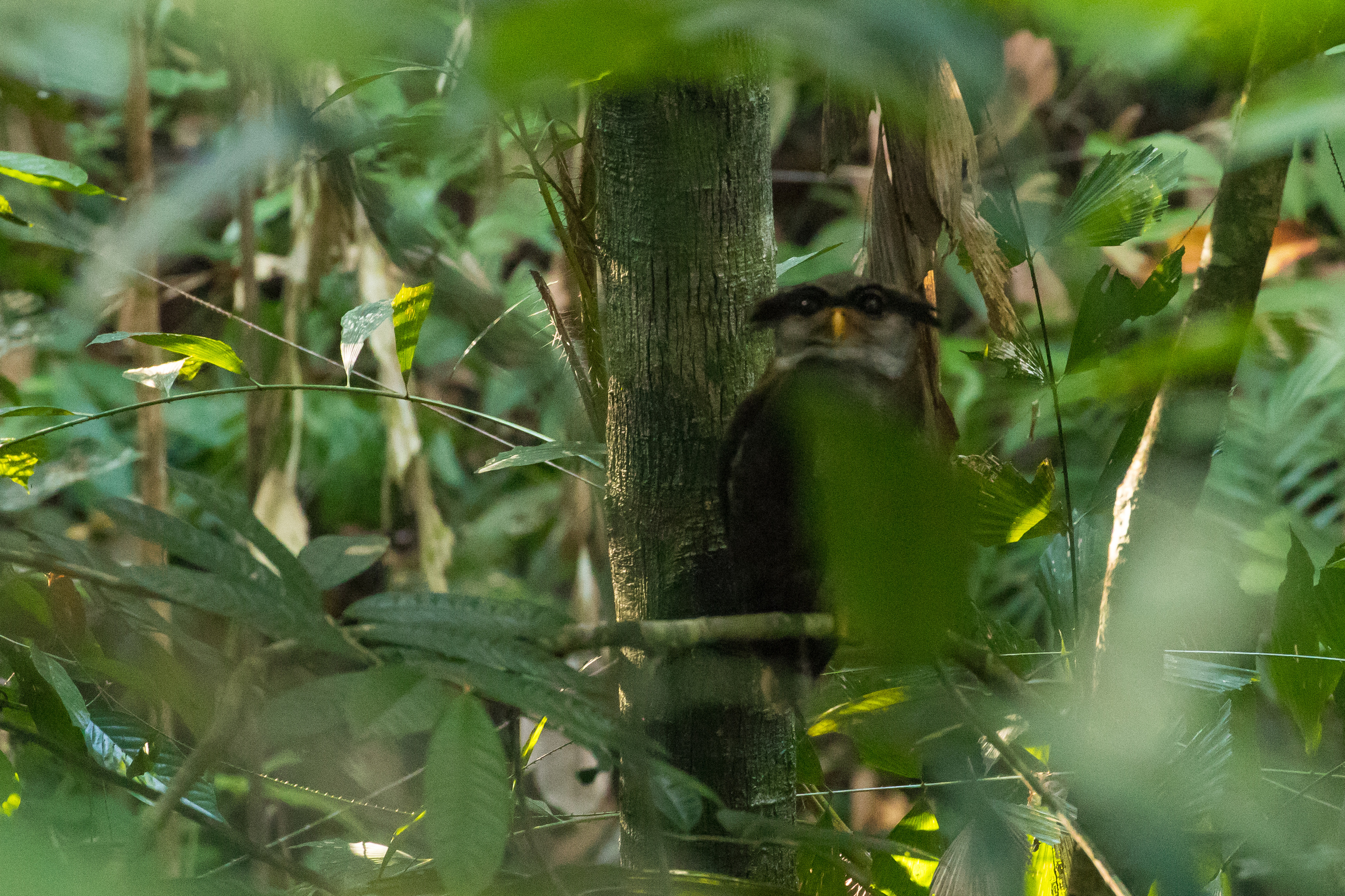
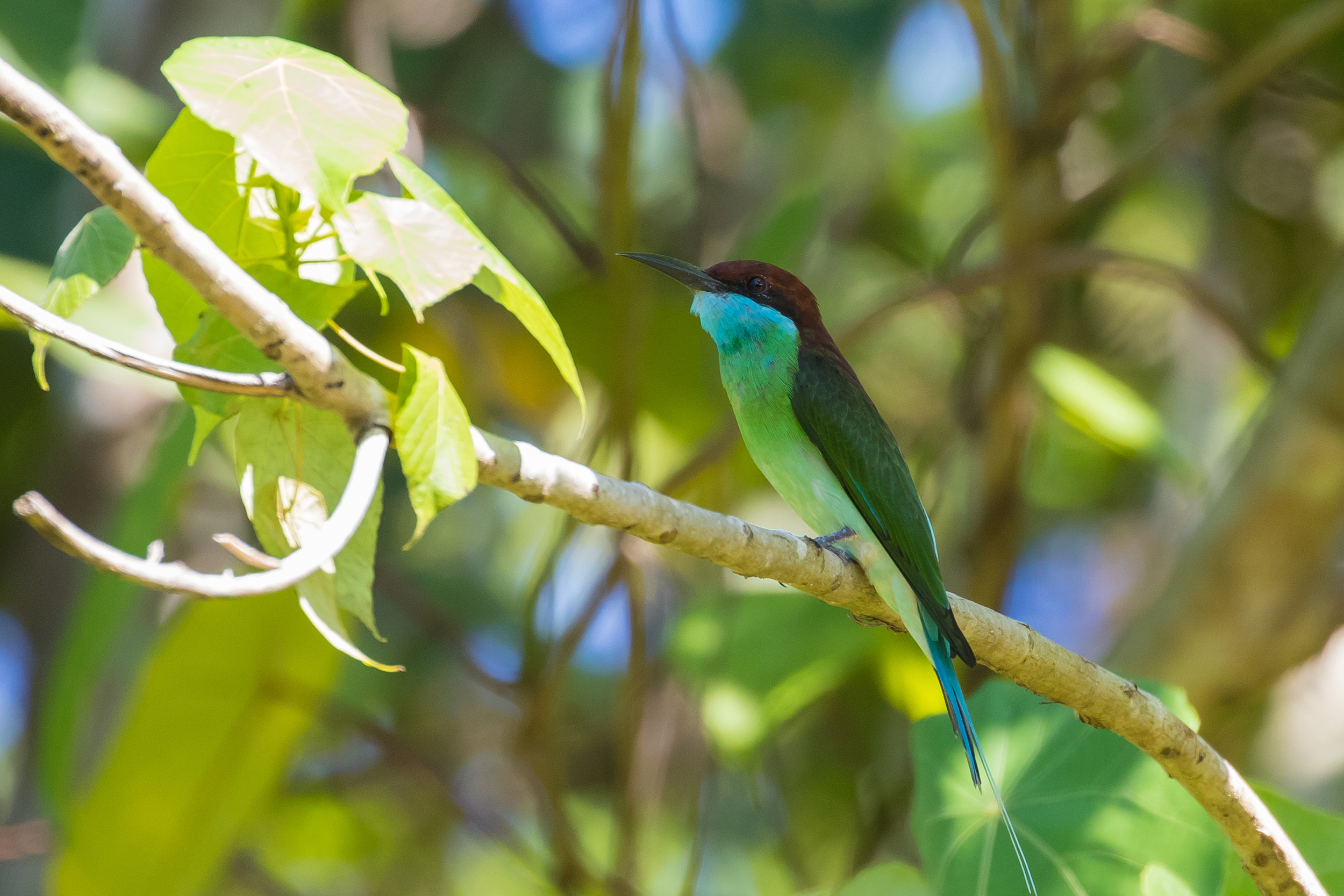
Mid-morning Robert Chong picked us up for a transfer to Bilit in the Kinabatang Jungle Reserve, about 100km and 2 hours’ drive away (Borneo roads are not made for fast smooth travel!). Robert used to be part-owner of Kinabatang Jungle Camp (where I stayed in 2014) but is no longer involved in the KJC (which by all accounts has gone way downhill) and is semi-retired. We stayed in the Borneo Natural Sukau Bilit Resort about 6km upstream from KJC. Our room, overlooking a small oxbow lake, was lovely, and the dining room – right on the river – meant we could sit on the deck at meal-times and watch the wildlife as we ate. On our very first evening we had just finished eating when Erica looked up and exclaimed: “Look Dad! What’s that?” I turned to see a Buffy Fish Owl had just landed a few metres away on the edge of the deck. I rushed back to the room to get camera and flash but arrived back just in time to see it fly off.




We spent our first afternoon out on the river trying to track down White-crowned Hornbill. One called from about 1km upstream from the lodge, but would not come into view, other than at one point when we saw the silhouette of a hornbill glide behind some palms about 20m back from the riverbank. Those untickable views were the closest we got to WCH, one of the key birds I also missed in 2014. We spent the best part of an hour drifting back and forth along this same stretch where we continued to hear WCH, so our bird list for the afternoon was pretty meagre. I recall also clocking Oriental Pied Hornbill, Purple Heron, Great Egret and various Swiftlets (Glossy, Edible-nest, Mossy-nest) and a Common Sandpiper. We did, however have some nice other wildlife encounters, including Silver-leafed and Red-leafed Langur, Pig-tailed Macaque, Proboscis Monkey and Saltwater Crocodile!



15 November
Early morning we zipped downstream in our private boat – myself, Eri, Robert and the boatman – to a smaller, quieter tributary for some birding first thing this morning. My number one birding objective was to rectify an especially hurtful dip from 2014: Bornean Ground Cuckoo. Disappointingly, history would repeat itself. Despite hearing a bird (apparently going one better than many groups this year) we could not get it to come closer to us, so once again BGC went down a “heard only” on my list. Erica was remarkably patient with me, sitting for a couple of hours while we tried fruitlessly to coax it closer, thankful for the effective DEET we had liberally applied to keep the mozzies away. We noted a nice array of birds but nothing really special. New for the trip were Stork-billed Kingfisher and Blue-eared Kingfisher, Lesser Fish Eagle and a couple of Jerdon’s Baza, as well as padders such as Dollarbird, Pacific Swallow, Long-tailed Parakeet, Green Imperial Pigeon and Pink-necked Green-pigeon. Eri was kept somewhat entertained by a troop of Proboscis Monkeys that climbed one-by-one across the river on a rope draped by locals to allow the monkeys and Orangutans to cross safely away from the current and crocs.




We returned to the lodge for some lunch and a rest, before reconvening mid-afternoon to make a plan for the second boat trip of the day. Erica was keen to see Elephants, but the news yesterday had not been ideal: apparently a herd had travelled some way upstream a few days ago and had not been sighted recently. However this afternoon Robert arrived at our rendezvous in the dining room with some tantalising news. The herd had been seen less than a km upstream from our lodge. We decided to spend the afternoon looking for them.
We headed immediately in our tinny upstream to their last known spot. Disappointingly, but unsurprisingly, there was evidence they had crossed the river, but they had not lingered, moving off into the jungle away from the river-bank. Here’s where the experience of Robert, having lived and birded and tracked wildlife here for decades, needed to come into its own. He speculated that they had probably headed to an ox-bow lake a few hundred metres into the forest. If they stayed there, we would have no chance of seeing them. But there was also a chance they would have carried on, in time to spend the last few hours of daylight munching on the riverside grasses and bathing. We turned the boat and headed downstream several km, keeping an eye out for anything and keeping our finger and toes crossed. Other than a baby croc we saw almost nothing, even as we passed the area we expected they might emerge. We had obviously travelled a good km beyond the straight line Robert had metaphorically drawn, and I sensed that Eri was growing restless. I too had now basically given up hope, and had enough.
We came around one last bend a noticed something in the water by bank. Eri too had seen something and exclaimed: “What’s that? – It’s Elephants!”. Two bulbous heads poked above the water, betraying the presence of a pair of teenage elephants playing with each other!

They splashed about, wrestling and eating grass, oblivious to our presence, or at least ignoring us. After five minutes a mother and smaller youngster emerged from the jungle and slid down the bank to join them, and we found another couple as well, hanging back in the denser trees and scrub. Having put in the effort to find the elephants we were now able to enjoy some really special time; just us, the river and these majestic animals. They may be “Pygmy” but they are only marginally smaller than Asiatic (and until relatively recently lumped with that species). Twenty or more minutes had gone by when the tell-tale sound of an outboard could be heard around the bend and we were joined by another boat with about a dozen tourists, and then another boat, and another. By the time we left there were several boats, much like a twitch on a jeep safari, crowded around the animals. Though the presence of the other boats and around 50 punters didn’t spoil our enjoyment too much, we were incredibly grateful and blessed to have had the earlier “alone time” with the elephants. We departed as boats were still arriving, both on a high, Erica grinning from ear to ear and me getting quite emotional, relishing her enjoyment almost as much as the experience itself.
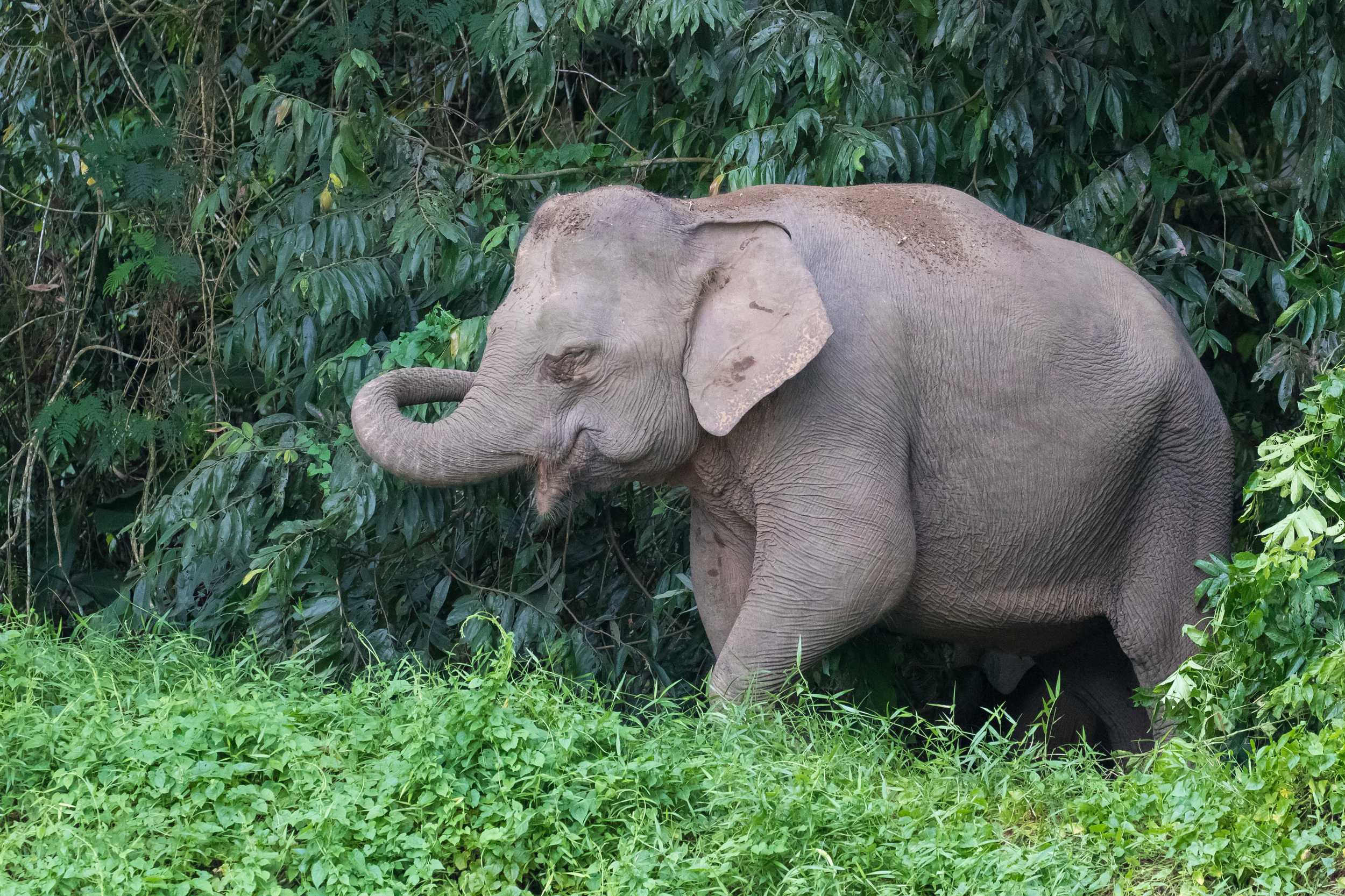
16 November
We started the day early, heading out onto the river with Robert as usual.

About a km downstream from the lodge our boatman slowed and pointed out to Robert something in the treetops. We couldn’t make out what they were looking at until Robert explained the guy had found a fresh Orangutan nest. Every night Orangs make a new “nest” for themselves, a platform of branches and leaves in the canopy. If we were lucky, we’d arrived in time for the builder to be there still. It was distant, but in fact, as we looked through binoculars we could just about make out what looked like a hairy arm draped on the lip of the nest. The hairy bit moved slightly and in doing so confirmed the the presence of an Orangutan, so we waited, hoping to see it emerge from the nest. It felt like an eternity, and I was torn between wanting to see a truly wild Orangutan, and to crack on with some birding at this optimal time of day. We must’ve waited for half an hour or more, when we realised that there were two animals, a baby and a mother. The former was behaving like a human baby – early morning, keen to get on with the day, and was being pulled back by mum who clearly wanted a bit more lie in. In the end we spent nearly an hour drifting up and back along this spot so we could watch mother and baby from afar. A pair of Rhinocerous Hornbills provided some distraction, and we also noted Wrinkled Hornbill and 3 endangered Storm’s Stork, as well as Oriental Reed-Warbler and Purple Heron. It was not an especially birdy morning.

We decided to spend the afternoon at the famous Gomantong Caves, about half an hour’s drive from Bilit. I didn’t visit this place on my previous trip but it is well known from various documentaries, not least in Episode 4 of Planet Earth! As we drove to the site Robert regaled us with stories of the crew who had enlisted his help.
From the car-park we walked abut 400m through secondary forest along a boardwalk to a clearing where there were a few huts, home to locals who harvest the nests of Edible-nest Swifts that live in the cave. Bizarrely, someone at some point decided that the nest of this particular species, made from the bird’s solidified saliva, is good to eat in soup. What a fucking ridiculous species we are!

The mouth of the cave loomed dark and large beyond the huts but we didn’t enter straight away. I could see a few swifts wheeling around and heard a Yellow-and-black Broadbill. Even though I have seen them several times before, I was keen to track this down for the trip because it’s such a funky looking species. As I scanned the trees in the cliff face in front of me Erica again exclaimed: “Dad, quick, look”. I thought she had the Broadbill so I turned and started scanning the trees in the direction she was looking. Her directions were poor, just a garbled jumble of words, and I was growing impatient unable to find the Broadbill myself when eventually she strung together a sentence that made sense: “No. On the boardwalk”. Broadbill on the boardwalk. “Unlikely, but possible”, I though as I lowered my gaze. On boardwalk, barely 30m, away was a female Orangutan.



A few minutes earlier we must’ve walked straight past her, within a metre or so. She clearly knew we were here and sat watching us as we kept still and low, taking photos and enjoying this intimate moment. After a few minutes, presumably comfortable enough that we were not a threat she lowered herself from the boardwalk and ambled over to a Jack Fruit tree. She climbed it quickly, grabbed a large fruit then immediately retreated to her spot on the boardwalk where she continued to watch us while eating her prize. Because of the intimacy and unexpected nature of this encounter, it was the most amazing and memorable experiences of the trip, justifying our travel on its own.
We decided to leave her and go into the cave. I had expected the stench of guano to be overwhelming – others have talked of retching and gagging at the smell — but though strong, neither of us was especially affronted by the smell. The number of cockroaches though, probably in their millions, was for Eri another natter. In places they swarmed over the guano below us so thick that we could not see the ground below them. Worse, though, they crawled in their thousands over the handrails of the boardwalk that has been constructed over the guano mound. Eri kept her hands in her pockets!
We noted the various swift species – Edible-nest, Mossy-nest, Black-nest and Plume-toed Swiftlets — as well as a few bat species that I don’t remember. Back outside the cave it was getting dark and I hoped we would be treated to the regular spectacle of bats emerging in their millions, and Bat Hawks picking one or two off for their dinner. Sadly, the dark clouds that were hastening dusk also seemed to dissuade the bats from coming out tonight, so we missed the show. We did find a few Bushy-crested Hornbills, a Crested Serpent-eagle, and a Hooded Pitta.
As we drove back through the Palm Oil plantations to get to Bilit we noted some of the only birds that do seem to thrive in the monoculture: Javan Myna, Greater Coucal and White-breasted Woodswallow.
After dinner we readied ourselves for another boat trip. I’d made it clear to Robert even before we came that while BGC, Orangutans and Elephants were our main targets during the day, I was very keen to have a crack at Oriental Bay Owl, a dip from my various prior trips to Malaysia and Thailand. We were joined for the evening by Romzi, who had been my personal guide when I came last time.
As we cruised slowly upstream in the dark, we scanned the banks with torches, regularly picking out eye-shine of resting crocodiles. This evidently spooked Eri sufficiently that, when we did come to shore and I followed Romzi into the forest, she stayed firmly in the boat!
We had travelled only a few hundred metres upstream when we found our first Buffy Fish Owl. Tonight I was able to get the shots I’d missed out on two nights earlier in the dining room. Not far away we heard an OBO, but it was distant and Romzi’s playback failed to bring it any closer so we carried on n the boat another few hundred metres. Another bird called and to my ears sounded similarly distant, but the experienced locals knew better and we pulled into the shore. The tactic was explained to me: Romzi would go in alone and find the bird, and then signal to the boat if/when he had it. This was obviously a routine they had down pat, because within a couple of minutes Robert leaned over and told me Romzi was ready – I should go in. I clambered up the bank, dragging myself up using the elephant grass, and walked gingerly through the dark jungle to where I could see Romzi’s torch. He motioned above and in his torchlight, clinging to a thin branch and calling gently in response to Romzi’s occasional playback, was an utterly stonking Oriental Bay Owl.


17 November
We had one more morning on the river and devoted it to birding. We began upstream a bit from the lodge hoping to claw back White-crowned Hornbill, but today did not even hear any. We did, however see Blue-throated Bee-eater and added the excellent Y&B Broadbill and R&B Broadbill (that’s Red-and-black, not Rhythm-and-blues) to the trip list. I also wanted one more crack at BGC; I guess I am a sucker for punishment. We noted Pacific Swallow, Asian Glossy Starling, Green Imperial Pigeon, Purple Heron and Great Egret as we chuntered downstream to the small tributary again. Once again, though, we would leave empty-handed. A bird called again, but once again steadfastly and stubbornly refused to come any closer to our playback. Five years ago I had decided to go into the forest to chase the bird, a low probability, last-resort option. In doing so I managed to get someone else a sighting, but dip myself (that is another tale). Today even this measure of desperation was off the table: we could hear the crashing and occasional trumpets of elephants in the jungle not far from where the GC was calling. Oriental Pied Hornbill and Wrinkled Hornbill were observed during this time, as well as Blue-eared Kingfisher, numerous Storms Stork (about 10) and a Jerdon’s Baza and Brahminy Kite. Waterbirds included Striated Heron, Little Egret and a Cinnamon Bittern.

Eri had been remarkably patient during this whole time, but after three hours in the boat it was time to head back to the lodge and drive back to Sandakan and fly to Kota Kinabalu. It was dark by the time we arrived to Mount Kinabalu for the next part of our adventure.


Very fantastic trip there! Looks like Erica got some good potential to be a nature lover like you? Glad to read that Robert is still in top shape. Love to go back for some of my nemesis. :)P
Lovely to hear from you Jennifer. Ro0bert on good form. Yet to convert Erica into a birder, but you’re right, she’s getting into nature. Shoebill and Gorillas next I hope 🙂